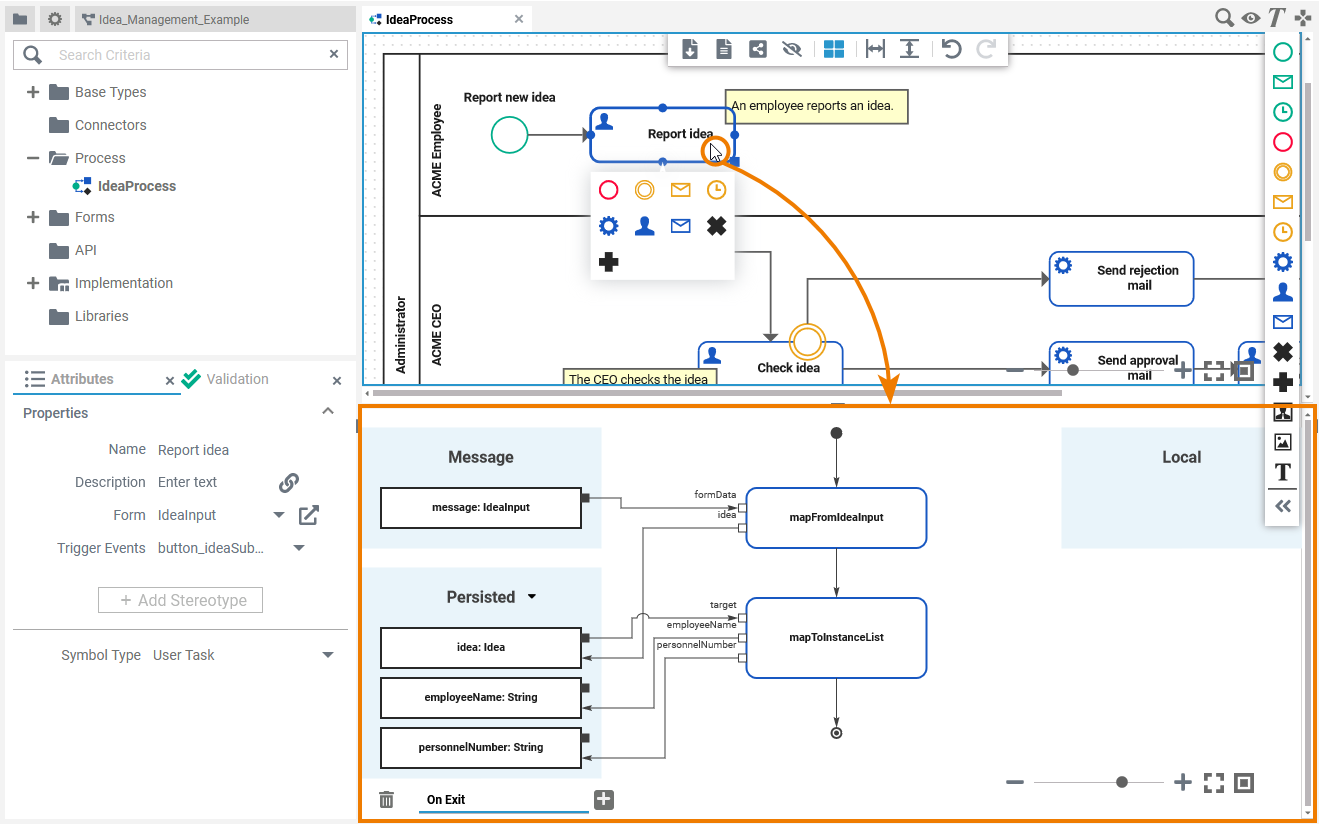- Created by Annegret Bernhardt on May 07, 2020
You are viewing an old version of this page. View the current version.
Compare with Current View Page History
Version 1 Next »
Once you have modeled your business process on the BPMN canvas, you have to add the necessary execution parts to this process to bring it to life. The execution canvas is the place where you make your model executable.
You need to perform two steps to implement executional parts to your model:
- Provide all necessary data types and operations for the implementation of your process. These types and operations reside in the Service panel of the BPMN editor.
- You can use the Base Types that are provided with the Designer.
- You can create other necessary types yourself in the Implementation section.
Refer to Modeling Data Mapping for further information. - You can import a library that provides additional types and operations.
Refer to Designer Administration > Libraries for further information.
- In the second step, select data types and operations from the Service panel, and add them to your process at the right places.
- How this is done will be explained in this chapter.
The Execution Canvas
The execution canvas is displayed below the BPMN canvas. It is shown as soon as you click on one of the BPMN elements:

The content of the execution canvas depends on the selected object on the BPMN canvas - three different views are possible:
| Selected BPMN Elements | Canvas Content | Execution Canvas View |
|---|---|---|
|
| |
|
| |
|
|
Execution Canvas Contents
| Section | Description |
|---|---|
UML activity diagram | The execution is modeled as a UML activity diagram. Every execution canvas contains an empty diagram with start and end node. |
Persisted | Variables created in section Persisted are usable in all executions of the BPMN model. |
| Local | Variables created in section Local are only available for use within the current execution. |
| Message | Section Message is shown for all BPM elements that need to process an incoming message. As per default, the incoming message has type any. To gain access to the data used in your process, you have to apply the correct type from a customized library. |
| Return | Only for outgoing relations of Exclusive Gateways Section Return is displayed, containing the unchangeable object return of type boolean. |
Customizing the Canvas
You have several options to adjust the canvas. When you open the canvas for the first time, the default view is displayed:
|
Managing the Canvas
MultiExcerpt named enlarge_canvas was not found -- Please check the page name and MultiExcerpt name used in the MultiExcerpt-Include macro | |
MultiExcerpt named hide_sidebar was not found -- Please check the page name and MultiExcerpt name used in the MultiExcerpt-Include macro | |
Use the |
Modeling on the Canvas
| Action | Example | Description |
|---|---|---|
| Zoom | When modeling, you have two options to apply the zoom on the canvas.
| |
| Shifting Content | You have various options to shift the content on the canvas:
| |
| Scaling | MultiExcerpt named fit_model_to_canvas was not found -- Please check the page name and MultiExcerpt name used in the MultiExcerpt-Include macro | |
MultiExcerpt named scale_model was not found -- Please check the page name and MultiExcerpt name used in the MultiExcerpt-Include macro |
The Execution Context Menus
Two different context menus support the user on the execution canvas:
Objects Context Menu | |
|---|---|
If you right click on an object, the tools context menu opens. Use it to edit the current object. The following options are available:
| |
| You can use the objects context menu on all objects on the execution canvas. | |
Execution Canvas Context Menu | |
A right click on the execution canvas opens another context menu including the following options:
| |
Shortcuts
You can also use the following shortcuts on the execution canvas. The operations are applied to the currently selected object. The following list of shortcurts can be searched. Enter your search term in the Global Filter field.
Oops, it seems that you need to place a table or a macro generating a table within the Table Filter macro.
The table is being loaded. Please wait for a bit ...
| Shortcuts | Description |
|---|---|
| CTRL + 1, 2, 3 ... 9 | Opens the tab corresponding to the chosen number. The first nine opened models are offered for activation. Press a number to activate the corresponding model and bring it to the foreground. |
| CTRL + D | Closes the active model window. |
| CTRL + Mouse Wheel | Reduces (scrolling down) or enlarges (scrolling up) the zoom factor of the model. |
| CTRL + SHIFT + D | Closes all tabs and switches to explorer tab. |
| CTRL + Y | Repeats editing steps that have been undone. |
| CTRL + Z | Undoes previous editing steps. |
| Del | Press Del to delete an object from the canvas. |
| Esc | Pressing the Esc key aborts the following processes:
|
| Mouse Wheel | Moves the model up or down. |
| SHIFT + Page down | Switches to the next tab from left to right. |
| SHIFT + Page up | Switches to the next tab from right to left. |
- No labels
